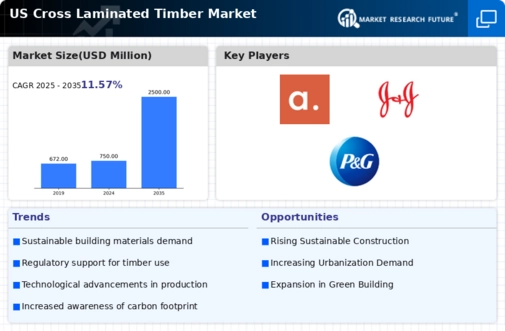Supportive Regulatory Frameworks
The cross laminated-timber market benefits from supportive regulatory frameworks that encourage the use of sustainable materials in construction. Various state and local governments in the US are implementing policies that promote green building practices, including incentives for using cross laminated timber. These regulations often include tax breaks, grants, and streamlined permitting processes for projects that utilize sustainable materials. As a result, builders are more inclined to incorporate cross laminated timber into their designs. The potential for financial incentives could lead to a 25% increase in the adoption of cross laminated timber in new construction projects over the next five years, further solidifying its position in the market.
Innovations in Manufacturing Processes
Innovations in manufacturing processes are significantly impacting the cross laminated-timber market. Advances in technology have led to improved production efficiency and product quality, making cross laminated timber more accessible to builders. Automated manufacturing techniques and precision engineering are reducing waste and enhancing the structural integrity of timber products. As a result, the cost of production is decreasing, which may lead to lower prices for consumers. The US market has seen a rise in the adoption of these innovative practices, with some manufacturers reporting reductions in production costs by up to 15%. This trend is likely to attract more players to the cross laminated-timber market, further stimulating growth.
Growing Awareness of Fire Safety and Building Codes
The cross laminated-timber market is influenced by the growing awareness of fire safety and evolving building codes. Recent advancements in fire-resistant treatments for timber products have improved the safety profile of cross laminated timber, making it a viable option for various construction applications. As building codes in the US become more stringent, there is a push for materials that not only meet safety standards but also offer aesthetic and environmental benefits. The cross laminated-timber market is likely to see an uptick in demand as architects and builders seek compliant materials that enhance safety without compromising design. This trend may result in a 15% increase in the use of cross laminated timber in commercial and residential projects.
Rising Demand for Sustainable Construction Materials
The cross laminated-timber market is experiencing a notable increase in demand driven by the growing emphasis on sustainable construction practices. As environmental concerns gain traction, builders and architects are increasingly opting for materials that minimize carbon footprints. Cross laminated timber, known for its renewable nature and lower emissions compared to traditional materials, aligns well with these sustainability goals. In the US, the market for sustainable building materials is projected to grow at a CAGR of approximately 10% over the next five years. This shift towards eco-friendly construction is likely to bolster the cross laminated-timber market, as stakeholders seek to comply with stringent environmental regulations and meet consumer preferences for green building solutions.
Increased Urbanization and Infrastructure Development
The cross laminated-timber market is poised for growth due to increased urbanization and infrastructure development in the US. As cities expand and populations grow, there is a heightened demand for efficient and sustainable building solutions. Cross laminated timber offers a lightweight yet strong alternative to traditional materials, making it ideal for high-rise buildings and urban projects. According to recent data, urban areas in the US are expected to see a construction boom, with an estimated increase in building permits by 20% over the next three years. This surge in construction activity is likely to drive the demand for cross laminated timber, as developers seek materials that meet both structural and environmental standards.














Leave a Comment